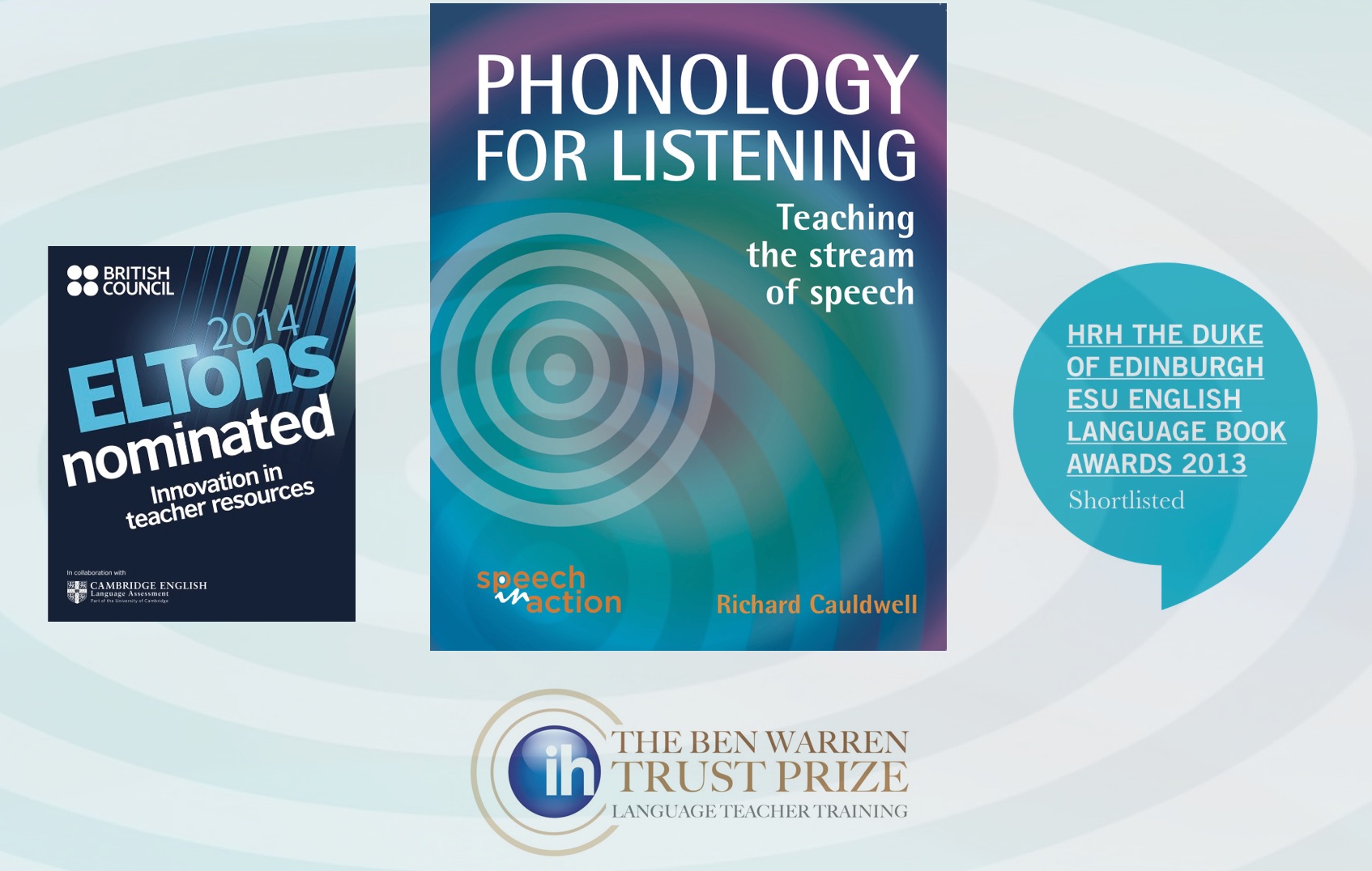Phonology for Listening
Buy print from BEBC or Amazon. Sound files are here.
First published in 2013, Phonology for Listening was shortlisted for three prizes: The British Council’s ELTon, the English Speaking Union’s Book Prize, and for the Ben Warren International House Trust prize. It has received unanimous praise from reviewers.
A masterpiece of its time … A veritable goldmine … Essential reading … Truly extraordinary … The most important ELT book I have read this year … Astonishingly comprehensive … Should be on every teacher’s bookshelf
Phonology for Listening: Teaching the Stream of Speech marks a revolutionary approach to the teaching of listening. It aims to help teachers how to teach decoding of the stream of speech of English. The aim is to help learners like Ying, who have difficulty catching words in the stream of speech:
I believe I need to learn what the word sounds like when it is used in the sentence. Because sometimes when a familiar word is used in a sentence, I couldn’t catch it. Maybe it changes somewhere when it is used in a sentence (Goh 1997, p. 366).
Phonology for Listening gives teachers new things to do in the listening classroom, to avoid criticisms of learners such as Anna:
I’ve hated the underuse of the material. I’ve … answered three silly questions … then someone tells me patronisingly (it IS bloody patronising) that the rest doesn’t matter. Well it does if I want to learn the language!
Phonology for Listening addresses the plight of the listener who has to deal with everything that comes at them through their ears (and which they can’t control). It makes extensive use of recordings of spontaneous speech – and the focus is on fast everyday speech, and on the forces that crush words out of shape. It is best read in an electronic format, so that you have immediate access to the examples.
Phonology for listening comes in four parts.
The window on speech framework
 The Window on speech has five chapters, which give a comprehensive but easy-to-follow introduction to the rhythmic patterns of speech, and intonation. It is these patterns – speech units – which are used to present, analyse, and teach the sound substance of the stream of speech.
The Window on speech has five chapters, which give a comprehensive but easy-to-follow introduction to the rhythmic patterns of speech, and intonation. It is these patterns – speech units – which are used to present, analyse, and teach the sound substance of the stream of speech.
Describing spontaneous speech
 Describing spontaneous speech has five chapters covering filled and silent pauses, ‘hesitations’ and re-starts, the many different soundshapes of weak forms and frequent words, and the many different soundshapes of content words. There is also an exploration of the rhythms of spontaneous speech.
Describing spontaneous speech has five chapters covering filled and silent pauses, ‘hesitations’ and re-starts, the many different soundshapes of weak forms and frequent words, and the many different soundshapes of content words. There is also an exploration of the rhythms of spontaneous speech.
Accents, identity and emotion in speech
 Accents, identity and emotion in speech has five chapters. They cover the differences between British and American pronunciation, regional accents of the UK and the USA, accents of Global English, and how emotion is conveyed in speech.
Accents, identity and emotion in speech has five chapters. They cover the differences between British and American pronunciation, regional accents of the UK and the USA, accents of Global English, and how emotion is conveyed in speech.
Teaching listening
 Teaching listening has five chapters. The first looks at issues in the teaching of listening; the second describes the mindset needed by teachers to deal with the realities of spontaneous speech; the third looks at using the teacher’s and students’ voices in low-tech listening exercises; the fourth, how listening comprehension exercises can be improved; the fifth looks at high-tech solutions.
Teaching listening has five chapters. The first looks at issues in the teaching of listening; the second describes the mindset needed by teachers to deal with the realities of spontaneous speech; the third looks at using the teacher’s and students’ voices in low-tech listening exercises; the fourth, how listening comprehension exercises can be improved; the fifth looks at high-tech solutions.
Author – Richard Cauldwell
 Phonology for Listening is written by Richard Cauldwell, who has two decades of experience in turning recordings of everyday speech into learning materials. His first publication Streaming Speech: Listening and Pronunciation for Advanced Learners of English won a British Council ELTon prize in 2004.
Phonology for Listening is written by Richard Cauldwell, who has two decades of experience in turning recordings of everyday speech into learning materials. His first publication Streaming Speech: Listening and Pronunciation for Advanced Learners of English won a British Council ELTon prize in 2004.


One Response to Phonology for Listening